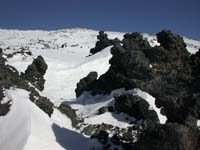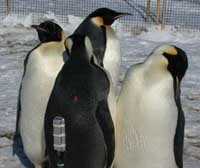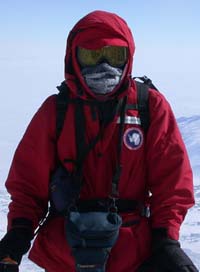|
|

|
|

|
Old
lava flows near the Fang Glacier.
|

|
|
|
|

|
|
A
Coal in the Icebox
|

|
by
Noel Wanner
December
10, 2001
Paul
and I just got back from six days up on Mt. Erebus, the volcano
that looms over everything down here. We drove a snowmobile
to the rim of the crater through a fantastic landscape of
snow, ice fumaroles, and lava towers. At 12,500 feet, with
the wind howling, we looked down from the ice-encrusted rim
into the bubbling, steaming lake of red lava below—a
furious island of heat in the midst of the ice.
|
|

|
|

|
Emperor
Penguins sunbathe
.
|

|
|
|
|

|
On
this continent, every living creature has its own pocket of
heat it needs to survive. Every bit of warmth is precious
for life. Some organisms have evolved to tolerate low temperatures
that would kill other organisms—tiny
Notothenoid
fish with "antifreeze" proteins in their blood
—while
others like Emperor penguins and Wedell seals have thick insulating
layers of fat and feathers or fur to help them retain their
body heat. Penguins allow the temperature of their feet to
fall close to freezing, thereby lessening the temperature
gradient between their feet and the ice beneath them. This
smaller gradient slows the rate of heat loss, allowing the
penguins to expend less energy keeping warm.
|
|
|

|
|
|
|
Paul
stays warm on the rim of
Erebus.
|
|
|
|
|
|
|
|
|
We
humans are not so well adapted to cold, so we have to compensate
with the clothes we've invented. The problem is that our internal
heat production varies widely with our level of activity.
As a result, we spend our time on the ice in a constant flurry
of clothing adjustment, trying to keep our internal temperatures
relatively constant. I keep thinking that we must look as
comical to the penguins as they look to us-- frantic naked
apes festooned with colorful cloth, shivering and jumping
about, while the Emperors calmly stand and preen their feathers.
|
|

|
|

|
No
berries for dinner tonight
.
|

|
|
|
|

|
On
Erebus, Paul and I were staying with a group of geophysicists
at a semi-permanent camp about two miles below the summit.
There were two huts with kerosene stoves providing heat where
we could eat and work when the weather turned bad, which it
did for about two days— minus 30 C and 40 knot winds,
resulting in a wind chill of about -60 C, plus a blizzard
of blowing snow and sulfurous vapour from the volcano. However,
each night we all slept in our tents, dug into the snow pack
outside—by far the coldest nights I've ever experienced.
To stay warm, we cocooned ourselves in thick sleeping bags.
In the morning, the collected moisture from my breath would
be condensed on the inside of the tent in a thick layer of
frost, which would then rain down on me like a miniature indoor
snowstorm. This, as you might imagine, does not improve your
mood in the morning. But we get up and put on our layers of
clothing. Outside, the wind howls. We go out to do our work,
alongside the scientists—another day of nursing our warmth,
struggling to preserve the coal in the icebox.
|

